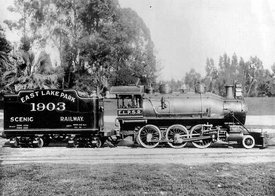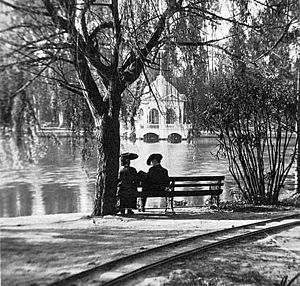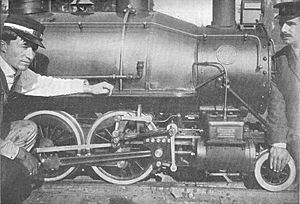Eastlake Park Scenic Railway facts for kids
Quick facts for kids Eastlake Park Scenic Railway |
|
|---|---|

Loco No 1903 of the Eastlake Park Scenic Railway
|
|
| Technical | |
| Line length | 984 m (3,228 feet) |
| Track gauge | 18 in (457 mm) |
| Maximum incline | 7 % |
The Eastlake Park Scenic Railway was a fun, small train ride in Los Angeles, California. It ran in what is now called Lincoln Park. This miniature railway was about 984 m (3,228 feet) (or 3,228 feet) long. It had a special track width, called a gauge, of 18 in (457 mm). This means the rails were only 18 inches apart! The railway operated for a short time, from May 19, 1904, to May 11, 1905. Later, a similar railway, the Venice Miniature Railway, took its place.
The Train Tracks
The railway's tracks were almost one kilometer (0.62 mi) (about 0.6 miles) long. They started near the main entrance of the park at a place called Lakeside Station. From there, the tracks crossed a part of the lake. They went over a strong bridge made of steel and concrete. This bridge was called a trestle bridge.
The train then traveled through a field of tall pampas grass. It curved around the edge of the park. The tracks even ran alongside the bigger railway line of the Southern Pacific Railroad. The path was lined with large fan palm trees.
The railway wound through a small forest of tropical plants. It finally reached the Hillside Station. This station was important because it had the locomotive shed. This is where the train engine was kept. There was also a double-track area. This allowed the engine to move to the other end of the train for the return trip. Hillside Station also had a water tower and an oil tank. These were needed to power the steam locomotive. There were also extra tracks, called sidings, and a place to buy tickets.
The railway had five switches. These are parts of the track that let the train change direction. The rails themselves were a special shape, called Vignoles. Each yard of rail weighed about 8 lb/yd (3.97 kg/m) (3.97 kg). Including the extra sidings, the total track length was about 1,045 m (3,428 feet) (3,428 feet). Over 1,700 sleepers were used. Sleepers are the wooden or concrete blocks that hold the rails in place.
The tightest curve on the track had a radius of 16.5 m (54 feet) (54 feet). This means the train made some pretty sharp turns! The Hillside Station was 5.4 m (17 feet 9 inches) (17.7 feet) higher than the Lakeside Station. The steepest part of the track, called the maximum grade, was 7 %. This steep section was about 9 m (29.53 feet) (29.5 feet) long.
Railway History
A man named John J. Coit built the tracks for this miniature railway. He also designed and likely built the steam locomotive. Before this, he was a skilled machinist. He had also built and run another successful miniature railway called the Long Beach and Asbury Park Railway.
John J. Coit had a physical disability for two years. This made him focus on making the locomotive easy to use. His friend, 'Shorty' Chase, was a person of short height. He always wore a suit and a bowler hat as a conductor on Coit's trains.
Abbot Kinney, who created the famous Venice of America, was very impressed by the Eastlake Park railway. He hired Coit to build another miniature railway. This new one was for his estate in Venice Beach.
Because a new locomotive for Venice was delayed, Coit temporarily moved his engine to Venice. The permit to run the Eastlake Park railway was canceled on May 11, 1905. So, the railway was sold at an auction. It was then used for the new Venice railway, which opened on July 4, 1905.
Coit returned to Eastlake Park in 1908 after a disagreement with Kinney. He operated his locomotive, No. 1903, and three passenger cars for about two more years. This was until around 1910. Later, he moved his train equipment to the Urbita Hot Springs Railway.
The Locomotive Engine
The main engine of the railway was an oil-fired steam locomotive named No. 1903. It was quite long, about 5.8 m (19 ft 0 in) (19 feet) from front to back. It stood about 1,295 mm (51 inches) (51 inches) tall from the rail to the top of its smokestack. This type of locomotive is called a 2-6-0 type. This number tells you how many wheels it has in different groups.
The locomotive had some clever new ideas. For example, it had a special valve control system. This system was easy to adjust and fix. The engine also had automatic couplings. These are special hooks that connect the train cars together easily. John J. Coit even got a patent for his unique oil burner design.
The locomotive and its tender (the car that carries fuel and water) weighed about 3,628 kg (7,998 lb) (8,000 pounds). Without the tender, the engine alone weighed about 2,328 kilograms (5,132 lb) (5,134 pounds). The tender could hold 780 L (210 US gal; 170 imp gal) (206 US gallons) of water. It also carried 322 L (85 US gallons; 71 imperial gallons) (85 US gallons) of oil for fuel.
The engine's weight was spread over six large driving wheels. These wheels were about 463 mm (18.2 in) (18 inches) across. It also had two smaller wheels at the front, called a pony truck. These were about 254 mm (10 in) (10 inches) in diameter. The train had a special Vanderbilt type boiler. This boiler could handle a lot of pressure, up to 10 bar (150 psi; 1,000 kPa) (145 psi). It produced about 25 horsepower (19 kW) of power. The locomotive had a strong pulling power of 4.8 kN (1,100 lbf) (1,079 pounds of force).
Passenger Cars
The passenger cars were designed for comfort. They had helical coil springs, which are like big coiled springs. These helped make the ride smooth. The cars sat on special wheel sets called bogies. Each car could hold ten people.
The cars were about 4.26 m (14.0 feet) (14 feet) long. They were also about 0.96 m (3.1 feet) (3.1 feet) wide. Each car weighed about 680 kg (1,500 lb) (1,500 pounds). Like the locomotive, they had Coit's automatic couplings at both ends. This made it easy to connect and disconnect the cars.
See also
- Billy Jones Wildcat Railroad
- Long Beach and Asbury Park Railway
- Seaside Park Railway
- Venice Miniature Railway
- Urbita Lake Railway




